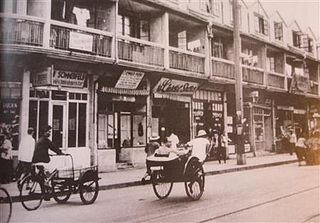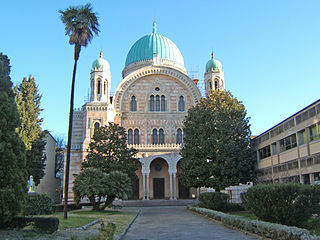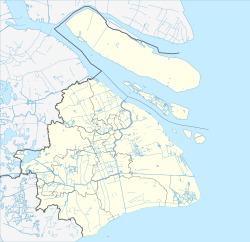Jews and Judaism in China are predominantly composed of Sephardi Jews and their descendants. Other Jewish ethnic divisions are also represented, including Ashkenazi Jews, Mizrahi Jews and a number of converts.

Yom HaZikaron laShoah ve-laG'vurah, known colloquially in Israel and abroad as Yom HaShoah and in English as Holocaust Remembrance Day, or Holocaust Day, is observed as Israel's day of commemoration for the approximately six million Jews murdered in the Holocaust by Nazi Germany and its collaborators, and for the Jewish resistance in that period. In Israel, it is a national memorial day. The first official commemorations took place in 1951, and the observance of the day was anchored in a law passed by the Knesset in 1959. It is held on the 27th of Nisan, unless the 27th would be adjacent to the Jewish Sabbath, in which case the date is shifted by a day.

, formerly spelled Hongkew, is a district of Shanghai, forming part of the northern urban core. It has a land area of 23.48 km2 (9.07 sq mi) and a population of 757,498 as of 2020.

The Ohel Leah Synagogue and its next-door neighbors, the Jewish Recreation Club and the Jewish Community Centre, have formed the center of Jewish social and religious life in Hong Kong for over a century. Originally the community was mostly Baghdadi and the synagogue was under the superintendence of the Haham of the Spanish and Portuguese Congregation of London: it is now fully independent and has members from across the Jewish diaspora.

The Shanghai Ghetto, formally known as the Restricted Sector for Stateless Refugees, was an area of approximately one square mile (2.6 km2) in the Hongkou district of Japanese-occupied Shanghai. The area included the community around the Ohel Moshe Synagogue. Shanghai was notable for a long period as the only place in the world that unconditionally offered refuge for Jews escaping from the Nazis. After the Japanese occupied all of Shanghai in 1941, the Japanese army forced about 23,000 of the city's Jewish refugees to be restricted or relocated to the Shanghai Ghetto from 1941 to 1945 by the Proclamation Concerning Restriction of Residence and Business of Stateless Refugees. It was one of the poorest and most crowded areas of the city. Local Jewish families and American Jewish charities aided them with shelter, food, and clothing. The Japanese authorities increasingly stepped up restrictions, surrounded the ghetto with barbed wire, and the local Chinese residents, whose living conditions were often as bad, did not leave. By 21 August 1941, the Japanese government closed Shanghai to Jewish immigration.
The Nederlands-Israëlitisch Kerkgenootschap (NIK) is the umbrella organisation for most Ashkenazi Jewish communities in the Netherlands, and is Orthodox in nature, while to be described as traditional in outlook. The expression Orthodox, is for the Dutch situation at least, of a later date than the existence of the congregations that make up the NIK and the NIK itself. The Rabbi of the NIK is Rabbi Dr. Raphael Evers. In total, the NIK has some 20 rabbis actively working in 18 congregations throughout the country, serving some 5,000 Jews.

The Mir Yeshiva, commonly known as the Mirrer Yeshiva or The Mir, was a Lithuanian yeshiva located in the town of Mir, Russian Empire. After relocating a number of times during World War II, it has evolved into three yeshivas: one in Jerusalem and two in Brooklyn, New York: the Mir Yeshiva, and Bais Hatalmud.

Jews were among the first settlers after Hong Kong became a British colony in 1841. The first Jews arrived in Hong Kong from various parts of the British Empire as merchants and colonial officials. Among the first wave, the Baghdadi Jews stood out especially, including representatives of the influential families of Sassoon and Kadoorie. The construction of the Ohel Leah Synagogue in 1901 marked the beginning of a fully fledged religious life for the city's local Jews.

Nachlaot is a cluster of 23 courtyard neighborhoods in central Jerusalem surrounding the Mahane Yehuda Market. It is known for its narrow, winding lanes, old-style housing, hidden courtyards and many small synagogues.

The Holocaust Memorial Synagogue is a synagogue located on Poklonnaya Hill in Moscow. It was built in 1998 to complement an Orthodox church and a mosque that are also part of the outdoor museum dedicated to Russia's victory in World War II.
Dr. Abraham Josevich Kaufman was a Russian-born medical doctor, community organizer and Zionist who helped protect some tens of thousands of Jews seeking safe-haven in East Asia from Nazi atrocities during World War II.
Joseph Asher (1921–1990) was an American rabbi born in Germany, known for his advocacy of reconciliation between the Jews and the Germans in the post-Holocaust era, and for his support for the civil rights movement in the United States. He was senior rabbi at Congregation Emanu-El in San Francisco for 19 years.

Robert de Besange, SJ, also known as Jacquinot de Besange and in China as Rao Jia-ju, was a French Jesuit who set up a successful model of safety zones that saved over half-a-million Chinese people during the Second Sino-Japanese War.

The history of the Jews in Florence can be traced over nine hundred years. Florence is the capital city of the Italian region of Tuscany and of the province of Florence. The Jews of Florence have one of the oldest continuous Jewish communities in Europe. The historic Jewish community in Florence is one of the largest and one of the most influential Jewish communities in Italy. The Jewish community in Florence also serves the smaller neighboring Jewish communities in Pisa, Livorno, and Siena.

The history of the Jews in Japan is well documented in modern times, with various traditions relating to much earlier eras.

The Ohel Rachel Synagogue is a Sephardi synagogue in Shanghai, China. Built by Sir Jacob Elias Sassoon in memory of his wife Rachel, it was completed in 1920 and consecrated in 1921. Ohel Rachel is the largest synagogue in the Far East, and one of the only two still standing in Shanghai. Repurposed first under the Japanese occupation during World War II and again following the Communist conquest of Shanghai in 1949, the synagogue has been a protected architectural landmark of the city since 1994. It was reopened for some Jewish holidays from 1999 and briefly held more regular Shabbat services as part of the 2010 Shanghai Expo.

The Beth Aharon Synagogue was a Sephardi synagogue in Shanghai, China, built in 1927 by the prominent businessman Silas Aaron Hardoon in memory of his father Aaron. During World War II, the synagogue provided refuge for the Mirrer yeshiva of Poland, the only Eastern European yeshiva to survive the Holocaust intact. After the establishment of the People's Republic of China, it was used by the Wenhui Bao newspaper and as a factory during the Cultural Revolution. It was demolished in 1985.

The New Synagogue was an Ashkenazi synagogue in Shanghai, China, opened in 1941 to serve the city's then growing Russian Jewish community. It was located on rue Tenant de la Tour in the Shanghai French Concession. The synagogue was closed in 1965 after the departure of most Jews from Shanghai following the Communist victory in China, and was repurposed as the auditorium of the Shanghai Institute of Education. It was demolished in the 1990s.

Rabbi Meir Ashkenazi was a Chabad rabbi who served as chief Rabbi of Shanghai from 1926 to 1949.


















